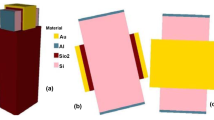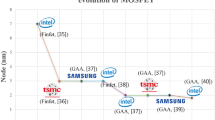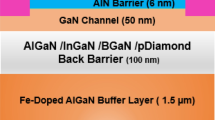Abstract
In this paper, a new two-dimensional analytical model for our proposed InAs/Si based double-gate dual-metal tunnel field-effect transistor (DG-TFET) with graphene nano-ribbon is presented. Incorporating group III-V material in source – channel junction, which in turn forms heterojunction results better device performance. Moreover, thin graphene nano-ribbon placed over intrinsic channel can tune the energy gap to larger extent, which supports better band-to-band (B2B) tunneling in our model. Direct tunneling model is used for Indium Arsenide (InAs), since it is direct bandgap material. Obtained Vth as 0.19 V, sub-threshold swing (SS) as 20.76 mV/decade and ION/IOFF ratio as 108 for the case of InAs/Si DG-TFET with graphene nano-ribbon shows an improvement of 48%, 36% and 10 decades respectively compared to conventional all-Si DG-TFET. Using 2-D TCAD numerical device simulator the proposed device model is designed and validated well with analytical data.
Similar content being viewed by others
References
Ionescu AM, Riel H (2011) Tunnel field-effect transistors as energy-efficient electronic switches. Nature 479(7373):329–337
Koswatta SO, Lundstrom MS, Nikonov DE (2009) Performance comparison between p-i-n tunneling transistors and conventional MOSFETs. IEEE Trans Electron Devices 56(3):456–465
Seabaugh AC, Zhang Q (2010) Low-voltage tunnel transistors for beyond CMOS logic. Proc IEEE 98(12):2095–2110
Choi WY, Park B-G, Lee JD, Liu T-JK (2007) Tunneling field-effect transistors (TFETs) with subthreshold swing (SS) less than 60 mV/dec. IEEE Electron Device Lett 28(8):743–745
Thomas N, Philip Wong HS (2017) The end of Moore’s law: a new beginning for information technology. IEEE J Comput Sci Eng 19(2):41–50
Dutta R, Konar SC, Paitya N (2020) Influence of gate and channel engineering on multigate tunnel FETs: a review. In: Maharatna K, Kanjilal M, Konar S, Nandi S, Das K (eds) Computational advancement in communication circuits and systems. Lecture notes in electrical engineering, vol 575. Springer
Madan J, Gupta RS, Chaujar R (2017) Mathematical modeling insight of hetero gate dielectric-dual material gate-GAA-tunnel FET for VLSI/analog applications. Microsyst Technol 23(9):4091–4098
Bardon MG, Neves HP, Puers R, Van Hoof C (2010) Pseudo two- dimensional model for double-gate tunnel FETs considering the junctions depletion regions. IEEE Trans Electron Devices 57(4):827–834
Ilatikhameneh H, Tan Y, Novakovic B, Klimeck G, Rahman R, Appenzeller J (2015) Tunnel field-effect transistors in 2-D transition metal Dichalcogenide materials. IEEE J Explor Solid-State Comput Devices Circuits 1:12–18. https://doi.org/10.1109/JXCDC.2015.2423096
Dutta R, Paitya N (2019) Electrical characteristics Assessmenton Heterojunction tunnel FET (HTFET) by optimizing various high-κ materials: HfO2/ZrO2. Int J of Innovative Technology and Exploring Engineering 8(10):393–396
Verhulst AS, Soree B, Leonelli D, Vandenberghe WG, Groeseneken G (2010) Modeling the single-gate, doublegate, and gate all-around tunnel field-effect transistor. J Appl Phys 107(2):024518
Choi WY, Lee W (2010) Hetero-gate-dielectric tunneling fieldeffect transistors. IEEE Trans Electron Devices 57(9):2317–2319
Saurabh S, Kumar MJ (2011) Novel attributes of a dual material gate nanoscale tunnel field-effect transistor. IEEE Trans Electron Devices 58(2):404–410
Pourfath M, Kosina H, Selberherr S (2007) Tunneling CNTFETs. J Comput Electron 6(1):243–246
Goharrizi AY, Pourfath M, Fathipour M, Kosina H (2012) Device performance of graphene nanoribbon field-effect transistors in the presence of line-edge roughness. IEEE Trans Electron Devices 59(12):3527–3532
Zhao P, Feenstra RM, Gu G, Jena D (2013) SymFET: a proposed symmetric graphene tunneling field-effect transistor. IEEE Trans Electron Devices 60(3):951–957
Hwang WS, Zhao P, Kim SG et al (2019) Room-temperature graphene-nanoribbon tunneling field-effect transistors. npj 2D Mater Appl 3:43
Jain P, Prabhat V, Ghosh B (2015) Dual metal-double gate tunnel field effect transistor with mono/hetero dielectric gate material. J Comput Electron 14(2):537–542
Cappy A et al (1980) Comparative Potential Performance of Si, GaAs, GaInAs, InAs Submicrometer-Gate FET’s. IEEE Trans. on Electron Devices ED-27(11)
Young KK (1989) Short-channel effect in fully depleted SOI MOSFETs. IEEE Trans Electron Devices 36(2):399–402
Dutta R, Paitya N (2019) TCAD performance analysis of P-I-N tunneling FETS under surrounded gate structure. SSRN-Elsevier
TCAD Atlas Manual, Silvaco, Inc., CA 95054, USA, 2015
Acknowledgements
This work was supported in part by All India Council for Technical Education (AICTE), Govt. of India under Research Promotion Scheme for North-East Region (RPS-NER) vide ref.: File No. 8-139/RIFD/RPS-NER/Policy-1/2018-19.
Special acknowledgement also goes to Dr. Nitai Paitya for facilitating the authors with Nanoelectronics Lab, Sikkim Manipal Institute of Technology (SMIT)- Sikkim, India, for this research work.
Author information
Authors and Affiliations
Corresponding author
Additional information
Publisher’s Note
Springer Nature remains neutral with regard to jurisdictional claims in published maps and institutional affiliations.
Rights and permissions
About this article
Cite this article
Dutta, R., Subash, T.D. & Paitya, N. InAs/Si Hetero-Junction Channel to Enhance the Performance of DG-TFET with Graphene Nanoribbon: an Analytical Model. Silicon 13, 1453–1459 (2021). https://doi.org/10.1007/s12633-020-00546-7
Received:
Accepted:
Published:
Issue Date:
DOI: https://doi.org/10.1007/s12633-020-00546-7




